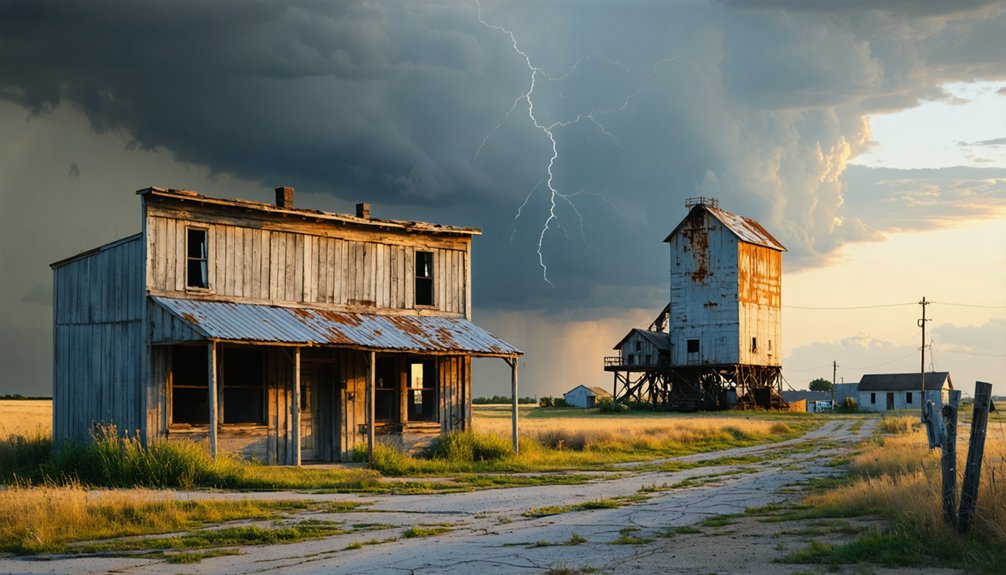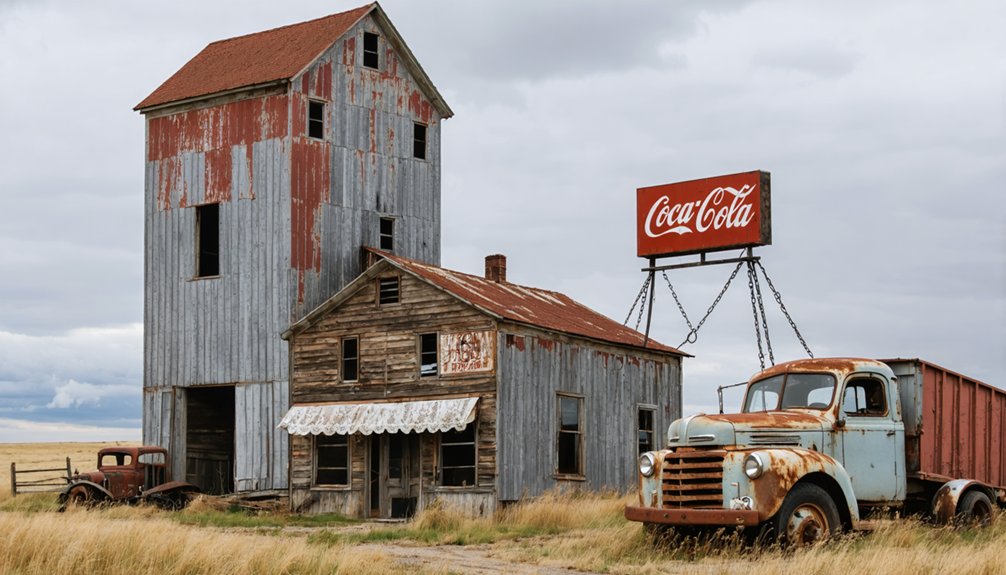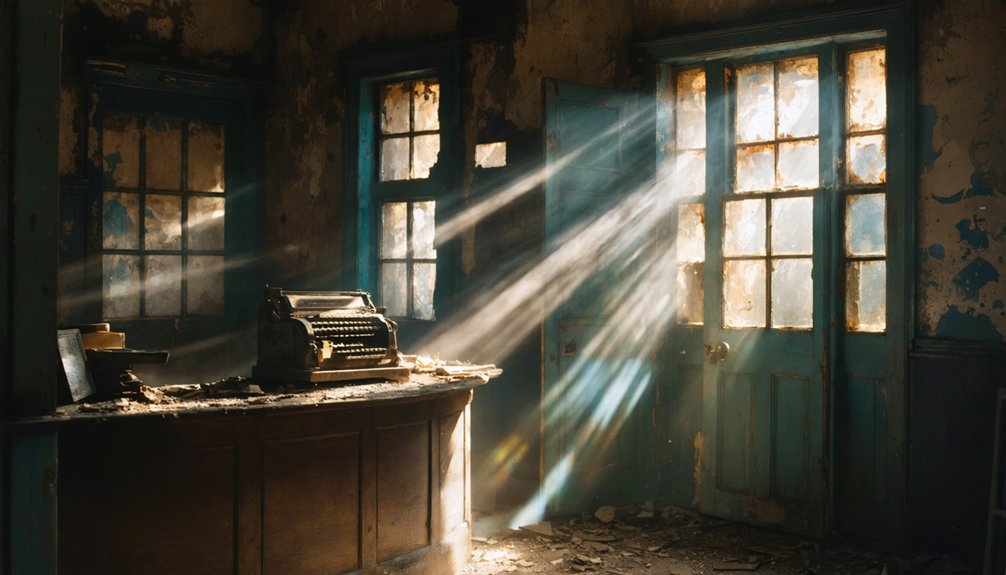You’ll find Bloomington’s haunting story along South Dakota’s Mni-sota river, where a thriving frontier settlement met a violent end in 1877. Originally home to Dakota peoples for 3,000 years, the town developed into a modest farming community after Peter Quinn’s 1842 settlement. When armed outlaws systematically terrorized residents through intimidation and violence, the entire population fled, leaving behind scattered foundational stones that whisper tales of frontier lawlessness and lost dreams.
Key Takeaways
- Bloomington was a modest farming settlement in Clay County, South Dakota, with strong Dakota indigenous roots dating back 3,000 years.
- The town reached its peak population of about 100 residents before violent criminal groups forcibly took control in 1877.
- Armed outlaws systematically terrorized residents through intimidation and violence, causing residents to flee and abandon the settlement entirely.
- The criminal takeover transformed Bloomington into a permanent ghost town, with criminals destroying most structures and physical evidence.
- Today, only scattered foundational stones remain, with the site preserved through oral histories and educational programs by local historical societies.
The Rise of a Frontier Settlement
Before European settlement transformed the landscape, the Dakota people maintained a vibrant presence in what would become Bloomington, South Dakota.
You’ll find evidence of their 3,000-year history in the burial mounds along the bluffs, where ancient Mound Builders once thrived in this resource-rich region.
The Dakota sustained their communities through settlements near the Mni-sota river, which provided essential resources for their people.
The Dakota called this sacred area Ta-ku-wa-kan Ti-pi, meaning “dwelling place of the gods.”
The frontier culture began shifting when fur traders arrived in the late 1700s, followed by Fort Snelling’s establishment in 1820.
The fort’s presence shaped early settlement challenges, initially restricting colonization while simultaneously serving as a catalyst for future development.
You’ll recognize Peter Quinn as the first non-indigenous settler in 1842, with the Pond brothers following in 1843.
Martin McLeod, who married into the Dakota community, helped bridge cultural divides during this pivotal change period.
A Violent End: The 1877 Destruction
A brutal raid by outlaws in 1877 brought Bloomington’s frontier story to an abrupt and violent end. The attack wasn’t isolated – it occurred during a period of widespread lawlessness across Dakota Territory, where outlaw raids terrorized settlements from Deadwood to the Black Hills. Visitors seeking historical information about these events should note that disambiguation pages help clarify different references to Deadwood’s complex history.
You’ll find no trace of Bloomington today; the destruction was so complete that survivors abandoned the town immediately, never to return. The nearby Quinn’s log cabin, built by the area’s first white settler in 1843, was also destroyed during the attack.
The violence reflected the era’s brutal reality, unfolding against a backdrop of regional tensions that included conflicts between settlers and Native Americans. While many frontier communities showed remarkable community resilience in the face of adversity, Bloomington’s fate was sealed that day in 1877.
Life in the Dakota Territory was unforgiving, where violence and conflict turned thriving frontier towns into distant memories.
The town joined the ranks of Dakota Territory’s ghost towns, remembered only through historical accounts and the tragic stories of its residents.
Life Before the Devastation
While settlers sought opportunity in Dakota Territory’s expanding frontier, Bloomington emerged as a modest but crucial community in Clay County during the mid-1800s. You’d have found about 100 residents at its peak, most of them farming families and laborers working the land or operating small businesses like general stores and blacksmith shops.
Life centered around agricultural practices, with the town serving as a crucial hub for local farmers. You’d have seen community gatherings at the chapel, where neighbors strengthened their bonds through religious services and social events. Like many communities that would become ghost towns, Bloomington’s early settlers had ambitious dreams for growth and prosperity. Much like the abandoned town of Rockerville’s mining camp, these settlements represented the hopeful beginnings of frontier development.
The town’s small schoolhouse provided education for children, while primitive roads connected you to regional markets. Despite limited infrastructure and seasonal challenges, Bloomington’s residents built a resilient community that supported itself through farming, trade, and local industry.
Criminal Elements and Lawlessness
You’ll find that Bloomington’s darkest chapter began in 1877 when a violent criminal faction, emboldened by the sparse law enforcement presence, seized control of the town’s daily operations.
The absence of established frontier justice systems left citizens vulnerable to extortion, theft, and intimidation from outlaw gangs who’d frequently clash with local business owners. Similar to The Sucker State, lawlessness and criminal enterprises thrived in the region’s early years before proper governance was established.
When U.S. Marshal Riordan finally arrived to restore order, he encountered a deeply entrenched criminal network that had thoroughly exploited the region’s isolation and lack of organized law enforcement. His reputation grew after he faced down and defeated Charlie Fugit in a tense gunfight.
Violent Criminal Takeover 1877
During the tumultuous year of 1877, Bloomington’s peaceful existence north of Vermillion came to an abrupt end when violent criminal gangs seized control of the small Dakota Territory settlement.
Armed outlaws exploited the region’s minimal law enforcement presence, systematically terrorizing residents through intimidation, property seizures, and violence.
You’d have witnessed the complete breakdown of community resilience as these gangs dismantled local commerce and governance structures through extortion and theft.
That same year, Jack McCall’s execution in nearby Yankton demonstrated the territory’s growing efforts to establish law and order amid the chaos.
The settlement’s vulnerability, typical of frontier towns in the Dakota Territory, made it an easy target. The U.S. government’s sell or starve policy that same year contributed to widespread regional instability.
With no effective judicial system or consistent law enforcement to protect them, residents faced a devastating choice: flee or fall victim to the outlaws’ brutal regime.
The once-thriving settlement succumbed to abandonment, transforming into a permanent ghost town.
Frontier Justice Challenges
The absence of formal law enforcement in Bloomington and surrounding Dakota Territory settlements sparked the rise of vigilante justice groups known as “stranglers.” These self-appointed peacekeepers emerged as a direct response to the criminal takeover of 1877, operating throughout southwest North Dakota and the broader region.
You’d have found frontier justice particularly complex due to jurisdictional conflicts between tribal governments and state authorities, creating enforcement gaps that criminals readily exploited.
The region’s lawlessness intensified as political disputes undermined effective law enforcement, especially in borderland areas. Economic competition and social upheaval following the Dakota War of 1862 further destabilized the area, drawing bandits, rustlers, and outlaws who capitalized on the disorder.
While vigilante groups attempted to maintain order through extrajudicial punishment, their actions often reflected bias rather than impartial justice.
Law Enforcement Absence Impact
As law enforcement presence vanished from Bloomington in the late 1870s, criminal elements quickly seized control of the vulnerable settlement, establishing a pattern of lawlessness that would plague Dakota Territory ghost towns for decades.
The lawlessness dynamics transformed Bloomington into a haven for outlaws, where community responses often took the form of vigilante justice.
You’ll find these key impacts of law enforcement absence in Bloomington:
- Organized criminal groups exploited the town’s isolation, using abandoned buildings for illegal activities.
- Local residents resorted to extralegal justice measures, leading to cycles of revenge and violence.
- The lack of proper investigation and prosecution created an environment where criminals operated with near impunity.
These conditions ultimately accelerated Bloomington’s decline, as legitimate businesses and settlers avoided the dangerous, unprotected settlement.
Remnants and Historical Legacy
Located in Clay County, South Dakota, Bloomington’s physical remnants tell a sparse story of frontier violence, since criminals destroyed the settlement in 1877.
Unlike other Black Hills ghost towns that gradually declined, you’ll find few visible structures or ruins at Bloomington’s site. Historical archaeology might reveal scattered foundational stones or debris, but nature has largely reclaimed the area.
While towns like Rockerville and Mystic left behind preserved buildings and industrial remnants, Bloomington’s legacy lives primarily through community narratives of the lawless frontier era.
You won’t find the typical tourist markers or preserved buildings common to other ghost towns. Instead, Bloomington’s story serves as a stark reminder of the untamed forces that shaped South Dakota’s early settlement period.
Regional Impact and Significance

Moving beyond physical traces, Bloomington’s regional significance extends deep into Clay County’s developmental history.
During its brief existence, the town demonstrated settlement viability while fostering economic exchange between farmers, ranchers, and merchants in southeastern South Dakota. You’ll find its influence shaped early transportation networks and communication patterns that connected frontier communities.
Bloomington’s short-lived presence catalyzed vital trade relationships and established enduring routes between South Dakota’s frontier settlements.
Key impacts of Bloomington’s presence include:
- Established critical trade routes that opened surrounding agricultural lands for development
- Created a template for defensive community planning after its violent destruction in 1877
- Left an enduring legacy in local folklore that exemplifies the challenges of frontier life
The town’s abrupt end serves as a stark reminder of the volatile nature of frontier settlements, yet its brief existence helped lay the groundwork for Clay County’s eventual stability.
Preservation Efforts Through Time
Since its violent destruction in 1877, preservation efforts for Bloomington have primarily focused on documenting the town’s historical significance rather than physical conservation.
You’ll find that with no standing structures remaining, preservation activities have shifted toward archival research and archaeological surveys to understand early settlement patterns.
While local historical societies include Bloomington in their educational programs about South Dakota ghost towns, physical preservation has been limited by the site’s complete demolition.
Community involvement typically centers on maintaining oral histories and participating in broader regional heritage initiatives.
You might notice that unlike other ghost towns in the area that have received historic site designations, Bloomington’s preservation exists mainly through historical records and occasional archaeological documentation of any remaining foundations or artifacts.
Ghost Town Tourism and Memory

Despite Bloomington’s complete destruction and lack of standing structures, the ghost town has emerged as part of South Dakota’s dark tourism landscape, drawing visitors interested in the broader historical narrative of frontier settlement and decline.
Memory preservation efforts at Bloomington focus on interpreting the site’s story through local narratives and tourism ethics that respect both the past and present.
When you visit, you’ll find three key aspects that shape the ghost town experience:
- Interpretive markers detailing the town’s rise and fall
- Local oral histories shared by regional guides and historians
- Protected archaeological remnants that tell the story of frontier life
Your exploration of Bloomington contributes to a growing dark tourism market while helping preserve the collective memory of South Dakota’s settlement history.
Frequently Asked Questions
What Were the Names of the Criminals Who Destroyed Bloomington?
You won’t find specific names of those responsible – historical records don’t identify the criminals whose activity destroyed Bloomington in 1877, though their impact permanently shaped the region’s development.
How Many People Lived in Bloomington at Its Peak Population?
Like many frontier dreams, Bloomington’s peak population remains uncertain, but you’d likely find it matched similar ghost towns in the region, probably reaching between 100-150 people before outlaws sealed its fate.
Were There Any Notable Businesses or Industries in Bloomington?
You won’t find records of any major industries in this short-lived settlement. The business history was limited to basic agricultural activities before criminals destroyed the town in 1877, leading to economic decline.
Did Any Original Structures From Bloomington Survive Into the 20TH Century?
You won’t find any original structures that survived into the 20th century, as the town’s destruction in 1877 and lack of historical preservation efforts left nothing standing beyond the late 1800s.
What Indigenous Tribes Inhabited the Area Before Bloomington Was Established?
You’ll find rich tribal history in the area, where Dakota people displaced the Ioway tribe in the mid-1600s. Both groups left lasting cultural impact, with Dakota maintaining strong presence until European settlement began.
References
- https://en.everybodywiki.com/Bloomington
- https://www.sdpb.org/rural-life-and-history/2023-08-21/some-black-hills-ghost-towns-and-their-origins
- https://www.youtube.com/watch?v=Glucs_Rq8Xs
- https://www.powderhouselodge.com/black-hills-attractions/fun-attractions/ghost-towns-of-western-south-dakota/
- https://www.youtube.com/watch?v=_0WNYsFLSLA
- https://icatchshadows.com/okaton-and-cottonwood-a-photographic-visit-to-two-south-dakota-ghost-towns/
- https://en.wikipedia.org/wiki/List_of_ghost_towns_in_South_Dakota
- https://b1027.com/creepiest-coolest-ghost-towns-in-south-dakota-iowa-minnesota/
- https://www.ghosttowns.com/states/sd/sd.html
- https://www.bloomingtonmn.gov/sites/default/files/2023-03/South Loop History Report_Creative Placemaking.pdf



